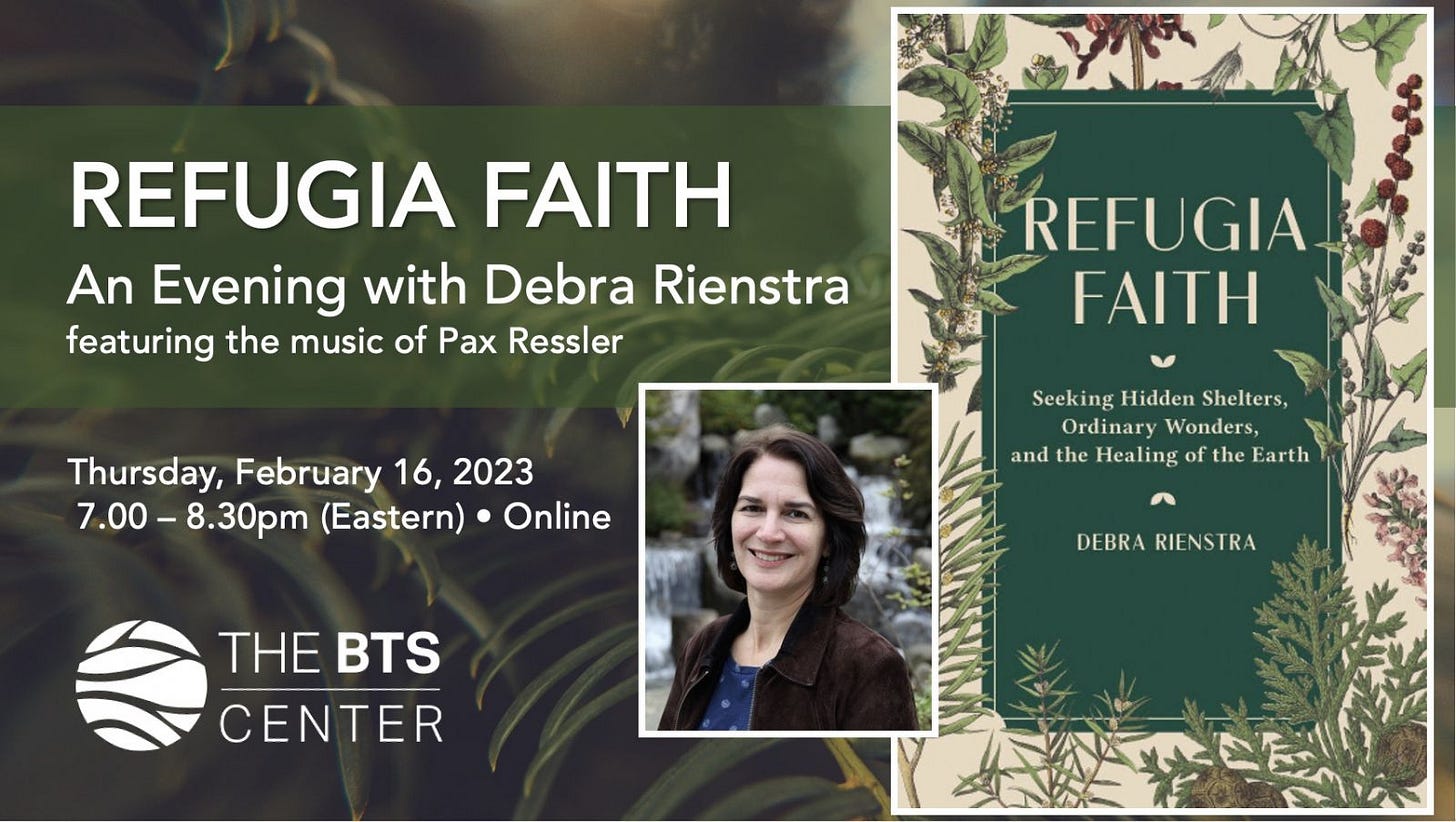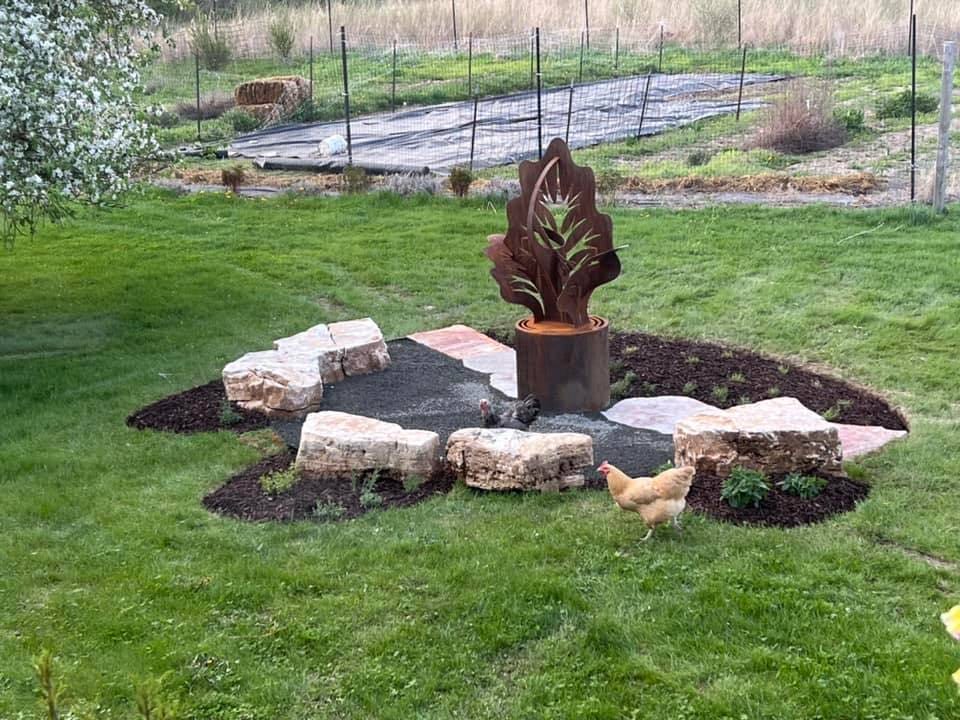Refugia Newsletter #34
Renewable energy progress, truth-telling, religions and climate, outdoor worship, and sugar cookies
Refugia News
Worship leaders and pastors from all over the world gathered on my campus this week for the Calvin Worship Symposium, hosted by the Calvin Institute of Christian Worship. I got to present on a panel called “What’s Missing from Models of Christian Formation?” and then do a solo session on Refugia Faith. Good experiences, both.
The people who showed up to these sessions, as one would expect, tended to know a bit about climate change. I got the impression from their questions and comments, though, that the people in their pews… paid little attention to climate issues. I showed a slide summarizing the recent Pew study on US religious people’s inaction on climate change, and people in the audience were dismayed but not surprised. (I wrote about the study in my Dec. 3 newsletter.) Folks in my sessions were, like me, struck by the study’s finding that only 8% of American are both “highly religious” and “very concerned about climate change.” That number continues to stick in my craw.
This coming week, I’m excited to be part of a wonderful event sponsored by the BTS Center in Maine. There will music, conversation about Refugia Faith, a panel discussion, and Q&A. I’ve only recently been introduced to the good folks and the BTS, whose mission is “to catalyze spiritual imagination, with enduring wisdom, for transformative faith leadership by offering theologically grounded programs of continuing education and spiritual formation.” They’re great folks. You are very welcome to join and can register here!
This Week in Climate News
Trying to keep track of all the climate news is overwhelming, even with so much good climate journalism and podcasting to help out. There’s just so much! So this week I want to focus on one question: How are we doing on the clean energy transition?
Three ways to answer that question today.
First, the US is predicted to reach about 25% renewable power generation in the next year or so. This, according to a federal government Short Term Energy Outlook report. Dan Gearino of Inside Climate News summarizes the report’s predictions, which he suggests should be taken as conservative projections:
From 2023 to 2024, renewables would rise from 24 percent to 26 percent of U.S. electricity generation; coal’s share would drop from 18 percent to 17 percent; gas would remain the leader but drop from 38 percent to 37 percent; and nuclear would be unchanged at 19 percent.
Here’s a nifty chart from the article:
That’s the US, but what about the international scene? CNBC’s Anmar Frangoul reports that the global market for clean energy tech will triple by 2030. This is based on a document released in January by the International Energy Agency. Frangoul writes:
In a statement accompanying its report, the IEA said its analysis showed that “the global market for key mass-manufactured clean energy technologies” would be worth roughly $650 billion per year by 2030, a more than three-fold increase from today’s levels.
Frangoul cautions that the estimate’s accuracy depends on countries making good on their green energy pledges. He also notes China’s continued dominance in manufacturing capacity, the fraught problems around mining necessary metals, and the fact that security concerns seem to be driving the transition even more than climate concerns.
Finally, Emma Marris, in The Atlantic’s climate newsletter, notes the global economic shifts now taking place around green energy transition. Since you may not be able to get past the paywall on this one, I’ll just share two juicy quotations. Marris notes:
Decarbonization is no longer framed as the enemy of economic growth. Instead, it is seen as an engine of economic growth. The “green economy” is becoming just “the economy.” [emphasis added]
However, as corporations and nations race to take gleeful capitalistic advantage of the transition, the challenge is to avoid making all the same mistakes all over again:
The goal is no longer to convince the world that climate change is real; it is to push for a “just transition” that will keep leaders focused on outcomes such as human-rights and ecosystem protection instead of merely dollars, euros, and yuan.
Deeper Dive
Can the world’s religions save us from ecological peril? It’s a great question—and the title of a beautiful essay by Paul Hond, appearing in Columbia Magazine (the alum magazine of Columbia University). I highly recommend the essay as a useful primer on the intersection of religion and the climate movement so far: it’s a quick history and an introduction to some key players.
The essay features Karenna Gore (yep, Al Gore’s daughter), who founded the Center for Earth Ethics. She has been trying to identify “the root causes of the climate problem,” philosophically speaking. Gore “identified two: the widespread belief that humans are separate from, and superior to, all other beings; and a value system that favors profit over environmental health.” [emphasis added]
Thanks to a number of key influencers—nicely introduced in the essay—religious people globally are joining in the efforts to correct those misconceptions and do the work:
As climate-linked weather events intensify and carbon emissions continue to rise globally, faith-based communities and institutions are emerging as pivotal players in the bid for environmental salvation.
The essay also features Mary Evelyn Tucker, one of those key influencers, mostly through her work at the Yale Forum on Religion and Ecology. Hond quotes Tucker:
She observes that all religions are broadening their teachings and practices in order to meet the ecological challenge. “Their theologies need to be expanded,” she says. “We call it retrieval, reevaluation, and reconstruction. All religions have something to offer, and that’s really the foundation for this new and emerging field.”
Bill McKibben’s newsletter this week hailed the planet’s truth-tellers, especially UN Secretary-General António Guterres, who laid down another zinger this week:
“We must end the merciless, relentless, senseless war on nature.”
Guterres had some deliciously pointed words for the fossil fuel industry, too.
The point is: Are religious people courageous enough to be among the truth-tellers? Or will they continue to avoid, deny, ignore? One of my favorite religious truth-tellers, Rev. Jim Antal, has been prophetically urging religious people (and everyone) to recognize our “communal vocation” at this point in human history. Jim’s ideas have been game-changers for me. (You can listen to my interview with Jim on the Refugia Podcast.) Here’s a sample from Jim’s Third Act Faith newsletter essay last week:
The call to address the climate crisis is a communal call; a universal call. You and I and everyone who are alive today have been given the opportunity to be part of what is the most consequential generation of human beings that has ever lived. The climate crisis places an inescapable moral claim on our generation and, therefore, on every one of us. It urges our generation to embrace a fresh understanding of human freedom, fulfillment, vocation and salvation. [emphasis added]
Image credit: Johanna Goodman, Columbia Magazine
Refugia Sighting
I’d like to introduce you to a new feature under the “Refugia Sightings” heading: the mini-interview. I’m grateful to Tim and Lori Diebel for agreeing to go first! I interviewed Tim about their “crazy” idea: an agricultural/spiritual refugium they’ve created in Iowa. Tim is a pastor and Lori an educator, both with doctoral degrees and professional careers. These days, though, they run Taproot Garden and “The Furrow”: an outdoor worship service that is part of the Wild Church network. You can find Tim’s blog here.
After careers in the ministry and academia, you and your wife took up small-scale regenerative agriculture. Did you have the sense that you were seeking what we might call a refugium—either for yourselves or to create one for others?
Lori is quick to clarify that, in the beginning, this was my [Tim’s] vision with which she supportively went along. Over time she has come to own it as well. The inspiration grew from the recognition that our food system is environmentally unsustainable. We had no prior knowledge or experience in agriculture, nor any imagination for the inclusion of laying hens and honeybees that have eventually joined us here. We simply wanted to be a part of the circle of memory holding onto the legacy of growing food on more natural terms. In that sense, we hoped to create a refugium for endangered agricultural practices.
You host an outdoor worship service once a month (not in winter!). What are the worshipers seeking when they join you for this service? What are they finding?
In the beginning, attendees were primarily friends from various connections who came to support us and the next “crazy” thing we were doing. That, along with the fact that we launched the service at the beginning of the pandemic’s second year and people were craving some semblance of social contact. An outdoor experience felt “safe.” What they experienced—which has prompted them to return with friends—is a deep and renewing breath, cradled in the arms of creation in an encounter that positions us to learn the ways of God through the instruction of creation. Together we listen, observe, and become a part of this environment that is infinitely larger and wiser than ourselves.
How do you see the role of refugia spaces in relation to the infrastructures of the institutional church?
Historically churches have been literal places of refuge for the accused, fugitives, and the abused. That role has been spiritualized—if acknowledged at all—but largely displaced by other, more active and proclamatory pursuits. The world with all its precarities, dangers and hurts needs churches to recall their historic role as protectors—shelters for restoration and regeneration. At a literal level, churches have buildings and properties (in many cases more bricks, mortar and lawns than people) that could be creatively turned to such missional use. Metaphorically, the church could spend less time telling the world what it should believe and more time demonstrating what we understand God wants us collectively to do: encourage life in its abundant thriving. “Eden care” at a local and universal level.
Image credit: Taproot Garden Facebook
The Wayback Machine
One of my students asked me this week if my husband and I had any plans for Valentine’s Day. I laughed and replied that we’ve been married 35 years, we’re both academics, and Valentine’s Day is on a Tuesday. So: no. I mean, maybe we’ll come up with something? Maybe? We’ll see how all the grading goes…
That little exchange reminded me of a silly piece I wrote in 2020. Well, actually a certain mysterious advice columnist who goes by “Pious Petunia” wrote this piece. If mid-February has you musing yet again at the various absurdities of Valentine’s Day, you might enjoy this one.
Whatever comes your way in the sometimes difficult month of February, I wish you good work, good companions, and good rest.








